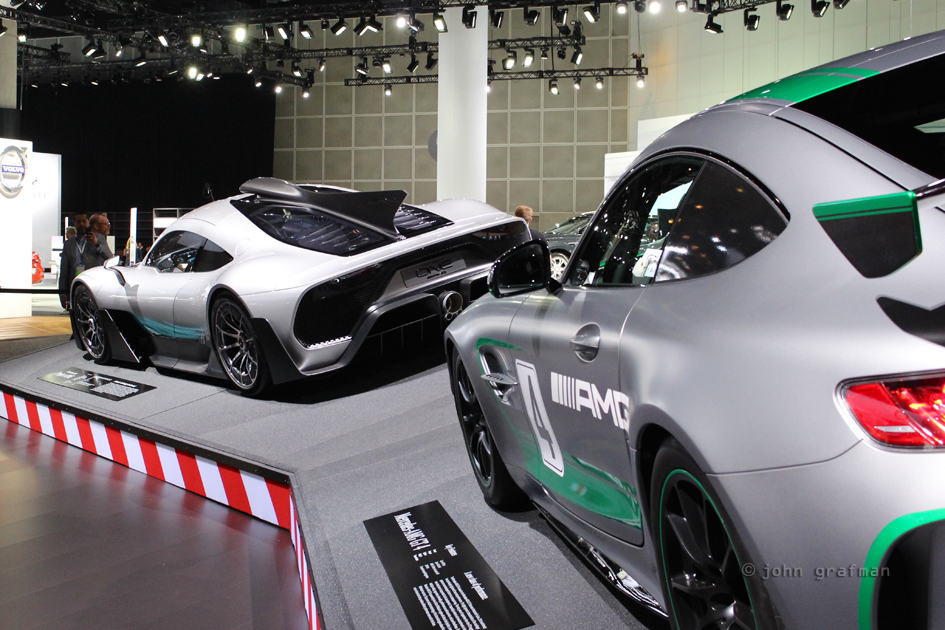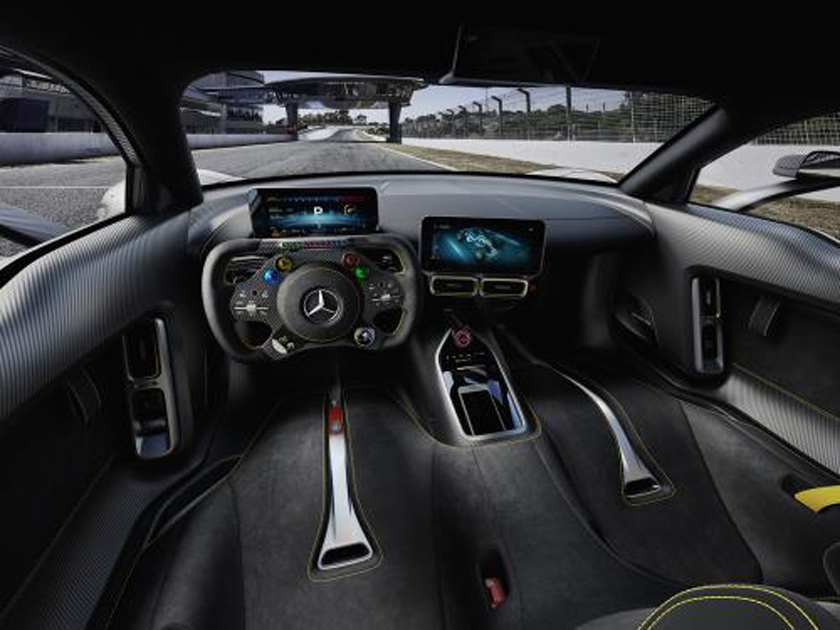Photos by John Grafman (unless otherwise noted)
The design of the show car is very obviously inspired by the premium class in motorsport. But above all, it embodies the Mercedes-AMG principle that fascination is always linked with function. Every part has a specific purpose. The result is a mid-engine concept, extremely muscular proportions with the cockpit well forward, large wheel arches, a wasp waist and an extended rear end.
“The Mercedes-AMG Project ONE is the hottest and coolest car we have ever designed. It combines our design philosophy of Sensual Purity with the performance of our Formula 1 racing cars and is the perfect embodiment of Performance Luxury,” says Gorden Wagener, Chief Design Officer Daimler AG. “This hypercar’s extreme design marks a milestone in design – there are no lines, and the interior is stripped down to the essentials.”
Front view: Powerful and functional
The front view is characterized by the large front fascia, the various air inlets of which extend across the entire vehicle width. The trapezoidal center section bears a large, white AMG logo. Above it, on the vehicle body, is the Mercedes star. The hallmark AMG A-wing below the center section creates a silver- colored highlight, and seamlessly transitions into the front fenders.
On the left and right are large, prominent air inlets which are framed by U- shaped flaps and each subdivided by two black horizontal fins. Flat LED headlamps blend seamlessly into the body contours.
The black air outlets in the hood guide the hot airflow around the sides of the driver compartment. This allows the flow of fresh air to pass unhindered across the driver compartment and into the intake tract on the roof. The downforce at the front axle is positively influenced by the automatically extending front splitter and the active ventilation louvers in the front wheel arches, contributing to the perfect aerobalance of the car.
Taut flanks, large fenders
The low, dynamic greenhouse has an unmistakable, spherical architecture with a distinctive window pattern. The large, dark area stands for important technical functions. These technical components form a visual contrast to the clean overall lines of the vehicle.
The roof line is dominated by an air intake derived from Formula 1, via which the engine takes in large volumes of air. The black intake transitions elegantly into the black, vertical shark fin, which improves lateral stability when cornering at high speed. The rear window placed well to the rear is an integral part of the intake/roof-fin unit. It allows a view of the power unit. Two large NACA air inlets ensure optimum guidance of the airflows for the engine and transmission oil coolers located at the rear end.
The side view also shows a sensuous, clean surface design combined with functional features. The vehicle flanks are tautly recessed, with black carbon- fiber surfaces redirecting the airflow around the vehicle body as in motorsport.
The Petronas green paintbrush design on the flanks is the work of the artist who designed the paintwork for the Formula 1 racing car. All four wheels are spanned by tight-fitting, muscular fenders that appear ready to leap into action.
As in motor racing, the doors open both forwards and upwards. The fuel filler flap is at the rear right, the charge socket for the plug-in hybrid battery at the rear left.
Rear end: Fascination and function
The sharp, vertical spoiler lip and the large, two-section diffuser, which is interrupted by the central exhaust tailpipe, as well as the two-stage extendible rear aerofoil, contribute to aerodynamic efficiency and performance at high speeds. The design of the exhaust tailpipe with its large, round outlet and two further small, round apertures was adopted directly from the Formula 1 cars.
The muscular appearance is further enhanced by the rear fascia with its large, black mesh and carbon-fiber components. The rear lights each feature three rhomboid lighting elements to echo the graphic design of the AMG brand logo, and therefore also the design of the headlamps.
Interior: Formula 1 for two
The interior design concept of this ultimate driving machine follows function on the racetrack, and this is expressed in the radical design idiom. Formula 1 technology is made authentically tangible on both the racetrack and on the road. Here too every detail has a function, with nothing included merely for visual reasons. In the monocoque interior, the reduced components are emphasized in minimalist style both in design and functional terms.
The ergonomically contoured interior has room for two occupants. The bucket seats with adjustable backrests are integrated into the monocoque. The pedals and steering wheel are adjustable, allowing the driver to adopt the ideal driving position. The center tunnel visually separates the driver and passenger areas from each other. It blends fully into the seat sculpture and follows the principle of minimalism with its gently rising contour.
Interior with functional structural parts
The lightweight construction is also obvious from the slim, wing-like profile of the dashboard. It appears to be light and free-floating. As a functional, structural component it also makes the monocoque of the Mercedes-AMG
Project ONE more rigid. The two high-resolution, free-standing 10-inch displays (one slightly raised in front of the driver, the other on the right of the center console angled towards the driver) are adapted with high-quality and weight- optimized solid metal components.
The double-nozzle ventilation unit is suspended under the center screen like a gondola. The screen and nozzles form a single unit, emphasizing the lightweight design principle of the whole. The displays’ rectangular basic form is echoed by the ventilation nozzles, and by the center console in which the start/stop button is located.
Also seamlessly integrated as a unit are a high-quality stowage compartment, a reduced switch array and the engine start button. The stowage compartment is fitted with a transparent lid.
Formula 1-style steering wheel
The steering wheel with flattened upper and lower sections and an integrated airbag offers motorsport functionality, as do the two integrated controllers which can be used to set adjustment functions such as the driving modes and suspension setup, or the LED shift display in the upper steering wheel area.
The door panels are in functional, high-grade carbon-fiber, and integrate smoothly into the sporty interior. As if to mirror the aero winglets of the exterior, the door paneling is visually interrupted to create space for technical implements and a generously concave door center panel. An aluminum cassette combines the air vents and power window switches, which are integrated as deeply recessed rectangles.
Stowage compartments behind the seats, screen replaces interior mirror.
Mercedes-AMG developers have ensured suitability for everyday use and operating convenience: small items can be stowed in two compartments on the left and right behind the seats. An air conditioning system and power windows are standard equipment, while the COMAND infotainment system ensures optimum connectivity.
The user interface is integrated as an autonomous concept. The most important information is displayed on the road in the line of vision above the steering wheel, so that the driver is not distracted. To ensure optimum visibility to the rear, the rear-view mirror is replaced by a screen showing real-time images of the rear from a mirror cam. The aluminum screen housing is fully integrated into the roof, and also holds other controls.
Colors and materials from the racing car
The choice of colors and materials takes its inspiration from the Mercedes- AMG Petronas Formula 1 racing car. The sculptured racing seats are in slip- resistant black microfiber, creating an unmistakable association with motor racing. The seat surfaces are interspersed with nappa leather in magma grey and inlays in a sporty textile mesh which optimally assists the air circulation of the seats. There is also yellow contrasting topstitching.


































